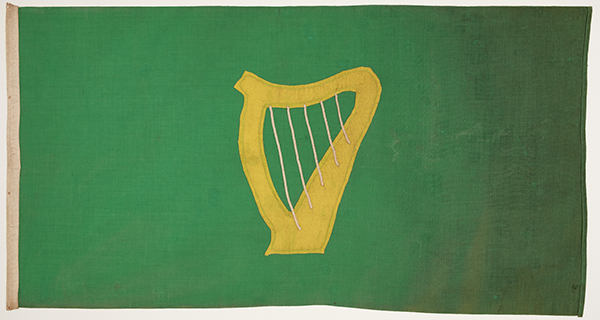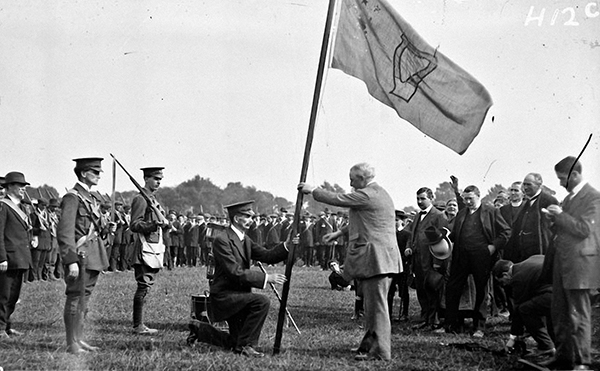Summoning her children to which flag?
Published in Features, Issue 6 (November/December 2016), Revolutionary Period 1912-23, Volume 24WHY WAS THE GREEN HARP FLAG NOT FLOWN ABOVE THE GPO DURING THE 1916 RISING?
By Emily Cullen
The delivery of the Irish flag and a copy of the Proclamation of the Irish Republic to all primary schools in the country this year was a potent reminder of the link between the 1916 Rising and the Tricolour. The very words of the Proclamation, in which Ireland ‘summons her children to her flag’, underline this connection. What is less widely known, however, is that the acknowledged flag of nationalist Ireland at the time of the Rising, and throughout the preceding century, was the Green Harp flag—a golden harp on a green background. While two flags flew over the GPO during Easter Week—the Tricolour at the corner of Henry Street and the ‘Irish Republic’ flag at the corner of Prince’s Street—it is significant that the harp device was absent from both. It is especially notable that the latter, which displayed the words ‘Irish Republic’ in white and gold lettering against a green background, did not include the harp, though a degree of confusion about this persists to this day. By spelling out the goal of the Rising, this flag also helped to ‘decode’ the meaning of the Tricolour for those who might have expected to see a Green Harp flag in its stead.

Above: The ‘Irish Republic’ flag that flew over the GPO at the corner of Prince’s Street at Easter 1916, now on display in the National Museum, Collins Barracks. (NMI)
Yet just a year earlier, in March 1915, Patrick Pearse, director of the Irish Volunteers, had issued the following order:
‘Every company of Irish Volunteers is to provide itself with an Irish Flag … The authorized flag is a plain gold harp on a green ground and no other flag, except authorized regimental colours, is to be carried by bodies of Irish Volunteers.’
Moreover, the Irish Volunteers had formally declared the Green Harp flag to be the Irish national flag in 1914, in guidelines issued by the Provisional Committee for the Colours of the Irish Volunteers. Designs for ‘regimental colours’ to be taken up by various units had been sanctioned. According to the O’Rahilly, who wrote on behalf of the committee:
‘The National Colour shows on a green ground the Golden Harp of Ireland with its nine silver strings, which is, as a matter of fact, the National Flag of Ireland. Its antiquity is well established.’
‘National Flag of the Sacred Green’
As the undisputed nationalist banner of nineteenth-century Ireland, the Green Harp flag has had a long history as an Irish symbol, stretching back at least to the thirteenth century. As early as 1642, on his return to Ireland from Rome, Owen Roe O’Neill flew a flag with a traditional Irish harp in yellow on a green field (and not the traditional royal blue). During the 1798 Rebellion the United Irishmen flew the Green Harp flag, and at least one United Irish proclamation referred to it as the ‘National Flag of the Sacred Green’. The flag was associated with Daniel O’Connell’s campaign for Catholic Emancipation in the 1820s and, subsequently, his Repeal movement of the 1840s. In his Young Ireland: a fragment of Irish history, 1840–1850, Charles Gavan Duffy informs us that the abiding memory carried away by the multitude who attended the monster meeting at the Hill of Tara in August 1843 was that of ‘the green [harp] flag they loved streaming in the wind’. When the government resolved to ban subsequent monster meetings, the Green Harp flag was used as a symbol of national solidarity, with occasional undertones of revolt. As well as the Young Irelanders at home, the Fenians deployed it overseas, incorporating a sunburst into the centre. As the nineteenth century progressed, this flag became widely associated with Charles Stewart Parnell when it was invoked as the principal symbol of the Irish Parliamentary Party in the 1870s and 1880s. All of this evidence reflects the fact that a large portion of the Irish population actively identified with the Green Harp flag during the nineteenth and early twentieth centuries. Why, then, was a decision taken to jettison the iconic harp symbolism when Patrick Pearse asked Eamon Bulfin to hoist the Tricolour above the GPO? Why did the Irish Tricolour—inspired by that of the French, which Thomas Francis Meagher had brought with him on his return from Paris in April 1848—take precedence over the long-established and beloved national flag? Or was this more of an implicit omission, since we know that, over at Liberty Hall, James Connolly was flying ‘the green flag of this country as a rallying point of our forces and embodiment of all our hopes’ throughout Easter Week? Why did it not remain our national flag in the wake of the Rising?

Above: The original Green Harp flag of the Irish Citizen Army that flew over Liberty Hall at Easter 1916. (Inniskillings Museum, Enniskillen)
Why was it discarded?
There are a number of reasons why the 1916 leaders chose to embrace this newer revolutionary symbol when James Connolly brought the Tricolour to the supreme council of the IRB on the night before the Rising.
The harp is one of the few Irish symbols that has endured over many centuries as both a separatist emblem and an icon of incorporation into the empire. The key addition or omission in the representation of either ideological stance is the crown. The crowned harp represented the link with the monarchy and the Union. (Indeed, the Irish harp still features prominently on a number of British coins owing to the fact that the royal arms of Britain constitutes the design theme of the coinage.) Uncrowned, it symbolised the heritage of Gaelic antiquity and the nationalist goal of political and cultural separatism. As a signifier of national identity, it carries a rich array of ideological associations and a history of adoption and dismissal at particular moments throughout Irish history. For example, when the new Police Service of Northern Ireland was being established in the North in 2002, the harp, which was integral to the old Royal Ulster Constabulary badge, was resolutely discarded because of its perceived historical baggage and connection to the older police force. There was a consensus that the symbols for the new police service should be free of all association with the symbols of the British and Irish states. The harp symbol, therefore, has been involved with both Ulster unionist mythology and republican separatist narratives through the ages. It expresses not a single uncontested identity and meaning but one that has a long history of appropriation and expropriation. G.A. Hayes McCoy, who chronicled some historical contexts for the use of the Green Harp flag, notes that:
‘The flag of a rebellion which had looked to France for support became the unquestioned symbol of an Ireland disillusioned and increasingly dissatisfied, and the fact that Ireland’s separate existence had been done away with made the symbol all the more to be cherished. For more than a century—for the period of the union—the green flag was waved by separatists and constitutionalists alike.’
Herein may lie the reason why the Green Harp flag was ultimately superseded by the Tricolour: while the harp was historically embraced by both revolutionary nationalists and Irish unionists because of its unifying potential, the Tricolour would be the unequivocal banner of a new independent Irish republic.

Above: John Redmond presenting a regimental flag bearing a harp to a unit of the National Volunteers in the Phoenix Park in
April 1915. (NLI)
A key iconic image from April 1915 shows John Redmond presenting a regimental flag bearing a harp to a unit of the (pro-war) National Volunteers at the Phoenix Park (above/below). This photograph speaks volumes about the associations that the Green Harp flag had accrued by this time. It adumbrates how the flag was perceived as being tied to an imperialist, ‘Home Rule’ context and to the British Army’s recruiting effort, even without the crown above the harp device. Although he still recognised the importance of honouring the Green Harp flag at Liberty Hall, James Connolly had also observed that ‘green flags wave over recruiting offices in Ireland and England as bait to lure on poor fools to dishonourable deaths in England’s uniform’. In the post-Rising period a bifurcation occurred in the use of national flags, whereby republican separatists in Sinn Féin tended to use the radical Tricolour as a sign of sympathy with the rebels while their rivals in the Irish Parliamentary Party used the Green Harp flag as a symbol of moderate constitutional nationalism. By the first anniversary of the Rising, the transformation of the Tricolour into the national flag was fully under way: Tricolours were flown from the GPO and Nelson’s Pillar in Dublin and from City Hall in Cork, while Tricolour wreaths were laid on the graves of the republican dead of the Rising in Dublin’s Glasnevin Cemetery. As Ewan Morris observes: ‘Its display in the years following the Rising was a reminder of Easter 1916 and an inspiration to keep up the campaign to make the republic a reality’.
Conclusion
We may never know for certain whether the Green Harp flag was deliberately excluded from the iconic affirmations of the nascent republic above its headquarters. The fact that the coffin of IRB founder Jeremiah O’Donovan Rossa was draped with the Tricolour on 1 August 1915 is revealing, as this funeral, at which Pearse delivered his famous graveside oration, was an important publicity event for the Irish Volunteers. The next notable speech by Pearse would be given outside the GPO at the outset of Easter Week 1916. By adopting the Tricolour, rather than perpetuating the Green Harp flag, the leaders of the Rising were sending a clear signal about the need for fresh, autonomous iconography for both a new Ireland and an Irish Republic. The Irish Tricolour of green, white and orange was adopted as the official flag of the Irish Republic in 1919 and this status was subsequently enshrined in the 1937 Constitution. While the harp remains the national emblem of Ireland, the Green Harp flag is now the banner of the province of Leinster and is known as the Arms of Ireland.
Emily Cullen is a Galway-based academic, poet and harper.
FURTHER READING
G.A. Hayes-McCoy, A history of Irish flags from earliest times (Dublin, 1979).
L. McBride (ed.), Images, icons and the Irish nationalist imagination (Dublin, 1999).
E. Morris, Our own devices: national symbols and political conflict in twentieth-century Ireland (Dublin, 2005).
S. Ó Brogáin, The Wolfhound guide to the Irish harp emblem (Dublin, 1998).
















